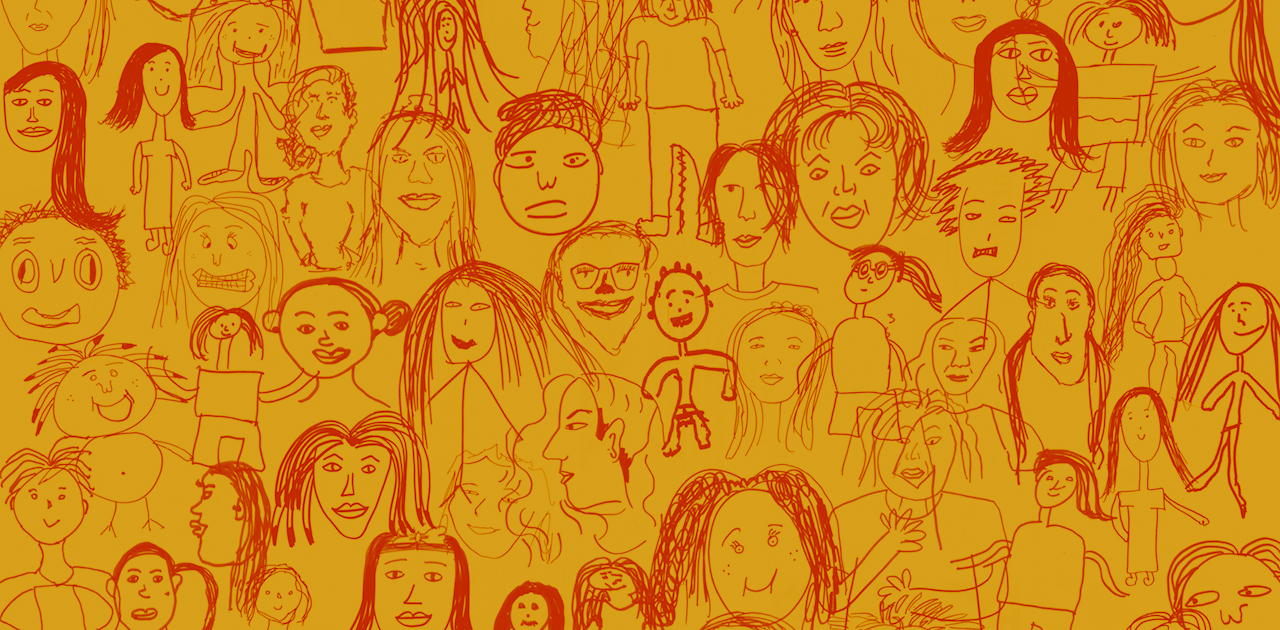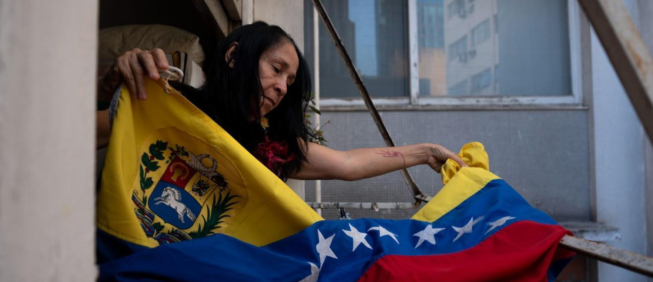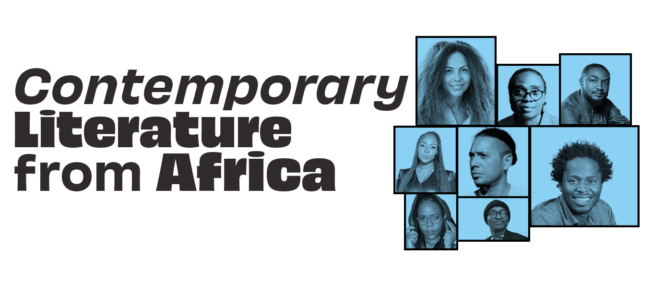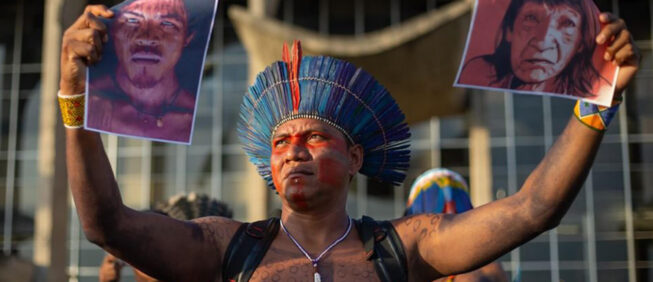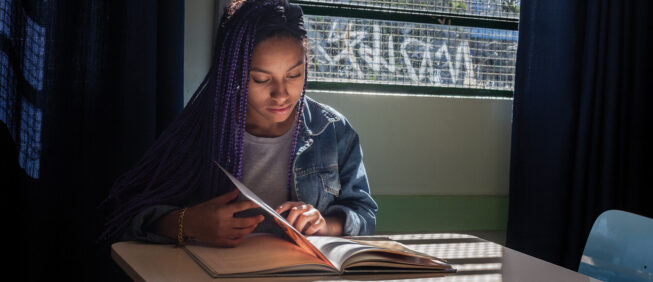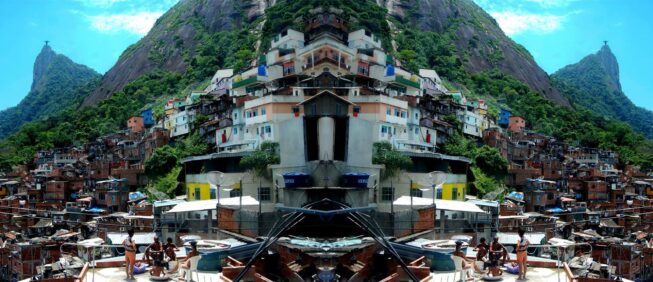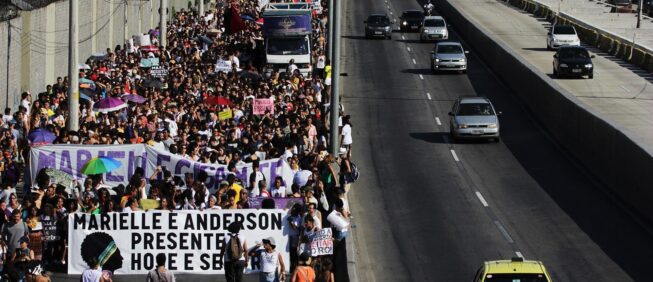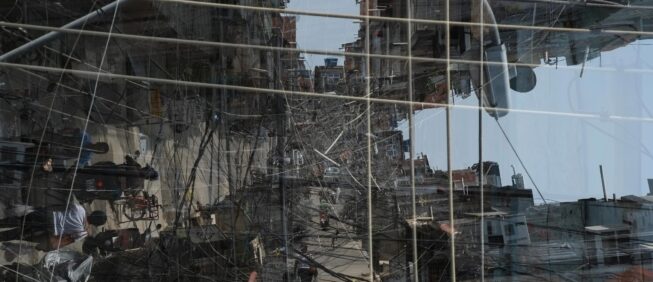Interview with Mujeres de Frente collective
Andrea Aguirre Salas and Elizabeth Pino reflect upon the feminist antipenitentiary actions of the collective founded in Quito
by Mario René Rodríguez Torres and Anderson Alves dos Santos
| Ecuador |
January, 2023
translated by Nicole Froio
Between 2003-2004 there was a cycle of prison riots in Ecuador. These disturbances coincided, beyond the cages, with a series of protests and strikes carried out by social movements, workers' organizations, students, women's groups, indigenous people, etc. The state responded to all this with violence. That was the context in which Mujeres de Frente emerged, a collective that has been working inside and outside of prison for 18 years, developing what they call an “anti-penitentiary feminist action.” In the following interview, several members of Mujeres de Frente talk about the history of the group, the actions they carry out, their reading of the recent prison crisis in Ecuador, as well as the local and international alliances they have established.
What is the origin of the collective?
Our collective was founded in 2004 in the Quito women's prison as an organized group of women prisoners and non-prisoners. In May of that year, intense prison riots made the problems of the prisons public, and made prisoners, among them women prisoners in the Quito women's prison, question citizens asking about the general and collective acceptance of the extremely precarious conditions of their lives, the always unjust extension of their sentences, the months, even years, that they could remain in prison without sentencing.
A group of non-prisoner women in Quito took on the responsibility and began to ask themselves why the social organizations of the left did not express their solidarity with these suffering people in any way, who are marked by antisociality. The organized working class seemed like a group apart, distant, far away and surely antagonistic to our cause. This was why the meeting was held — along the same lines of the riots — between incarcerated and non-incarcerated women, additionally, this meeting implied an opening of public discussions that challenged citizenry on the ground, in relation to the cruelty of this condition of life signified in a collective way, generalizing, at the social level, also a particular interpretation of the left. What working class people are recognizes as part of revolutionary struggle and, at the same time, as deserving of living in decent life conditions? Thus, the organization that emerged at that time was a feminist collective of self-awareness sustained in the women's prison in Quito.
What were the initial proposals, intervention strategies within and outside the prison, and the difficulties encountered in these early years of Mujeres de Frente and how did you manage to overcome them? What activities are currently taking place?
Our initial proposals had to do with the possibility of building a feminism based on inequality and difference. It seemed to all of us that we were part of a feminist self-organization dialogue that was valid and interesting and came from the middle-class, we found they were necessary, but not sufficient. An anti-racist, anti-capitalist feminism, in a country like ours, in a region like ours, necessarily implies bonds between interclass inequality, bonds that recognize the plots of racism that distance us from each other and that then build separations between us.
Our first objective, and the prison was the context, was the construction of a popular feminism that effectively put us in dialogue and cooperation with inequality, in the recognition of our inequalities of class, racialization, and at the same time, in recognition of our diversity, of our sexual diversity, of our diversity of possibilities and knowledge, of our diversity of intelligences. This is how Mujeres de Frente was built as an anti-penitentiary voice raised from grassroots, which found the prison as a context, but which intends to go beyond the concrete situation of the prison.
Our strategies of intervention within and outside the prison entailed sustaining permanent dialogues within the prison that began to demand exchanges of feminist self-awareness, popular education, collective writing, and so our journal Sitiadas was born, which, during the first year of our existence in prison, it was a mechanism to write together and get to know each other and understand what we have in common, and through which all the actions of the prison were planned, which involved bonds of solidarity with other collectives and social organizations, public demonstrations against punishment, public visibility of the particular situation of women in prison.
And so we also discovered our own difficulties and limits that we have to observe clearly as related to the social organization of punishment as a patriarchal logic so deeply rooted that it is practically unquestionable. However, as an abolitionist organization, we continue to encounter the difficulty of thinking of abolitionism as a horizon of possibility. At the same time, in an intimate and close way, we must permanently work with a difficulty that at the same time is straightforward, which are simply demands for the redistribution of resources, for the recognition of diverse voices and also for the management of the political organization, collective, in a context of deep hopelessness that is implanted in prisons. So transforming ourselves in our relationships, building trust, reciprocal care, and cooperation in the field of reproduction is a process that permanently accompanies our anti-punitivist public voice, so that today we are an organization that is made up of women prisoners, ex-incarcerated women, relatives of people in prison, self-employed street vendors, urban waste recyclers, sex and domestic workers, female workers and intellectuals, and also paid scholars, teachers and students.
Our organization, this dialogue against punishment and care in reciprocity, at this time involves a complex series of women gripped by the punitive powers of the State, not only penitentiary powers, the prison in particular, but the patriarchal punitive State in its more multiple expression. As self-employed merchants, for example, many of us women suffer from what we call “running around,” which means persecution by municipal police officers who seize our products and prevent us from selling them. There are multiple expressions of the patriarchal punitive space, such as, for example, police intolerance of sex work which can also be understood as police sexual abuse.
The forms in which the punitive State expresses itself are very diverse, which makes Mujeres de Frente, who was born inside the prison, today an organization that, from inside and outside the prison, organizes itself against punishment, against the punitive state inside and outside of prisons, against punitive culture, and also as a community of cooperation and care between women, boys, girls and adolescents that, at this time, implies accompaniment inside and outside the prison, economically productive projects, feminist economics exercises in which we experiment and think about the possibilities of collective construction of dignified work. Together, we also maintain a space for educational accompaniment, and the care that makes it possible, thanks to the redistribution of this work, for women mothers to find free time. In addition to a series of platforms of which we are a part, the Feminist Anti-Prison Network of Latin America, the Alliance Against Prisons in Ecuador, Laboratoria, a space that involves feminist organizations dedicated to co-investigation in Latin America and southern Europe , and of course a series of links and shared work with the feminist and women's movement in Ecuador, the anti-racist and anti-capitalist movement.
Between the first and the second edition of the magazine that you publish, the Sitiadas magazine, there was a period of two years (2004 - 2006), and between the second and the third edition, the interval was of 14 years (2006 - 2020). Why did it take so long to publish the third issue?
It is important to say that Sitiadas is a tool that we decided to experiment with in order to build a public voice and that, at the same time, it was an exercise in intimate elaboration that allows the recognition of each other. Sitiadas was one of the ways that we as a collective experienced, among others, as a space for popular education inside the prisons, where we excercised the processes of imagination and deployment of street political actions planned from inside the prison and executed outside the prisons, and sometimes, with fellow prisoners for whom permits were obtained, and always in dialogue with other social organizations, with whom, for those same years of 2004 to 2010, we built a social, countercultural center, the Casa Feminista de Rosa.
Thus, Sitiadas, among other political experiences of the organization, was published in its early years and then ceased to be published precisely because of the collective's organic concentration on other experiences and expressions. During those years we have experienced very diverse ways of cooperating, very diverse ways that have gone through the process of building literacy schools, completion of primary school, which today find expression in the feminist and popular political training school. This school was conceived precisely in the context of the massive pardon, of the so-called drug mules, that took place in Ecuador.
At that time, the apparently left-wing government promoted and, in fact, materialized pardons for the so-called drug mules, which involved the release of several colleagues from the organization. In this context, and always in an organic way, always in a collective way, we were identifying the transformation of our situation as a community, with a significant number of comrades being released. A colleague raised the importance of being able to have degrees, even if they were primary education, to be able to aspire to job alternatives, to participate in collective spaces; another comrade also raised the need to open the organization to comrades who were not necessarily released, or not necessarily imprisoned, so that our educational processes could be offered to comrades from popular sectors who required it.
This was also an effort to fight the stigma of prison. Many released comrades did not want to maintain that stigma or that sign as a central feature of their militancy, they wanted to get rid of prison. This is how we built, in 2008, the school for the completion of primary education and literacy, which included the work of women from popular sectors who were not prisoners, with whom we also began to think about the punitive state, and with whom we also began to understand how the punitive state operates far beyond prisons, even when it finds in prisons its most tenacious, its cruelest and its most brutal expression.
In these years, Mujeres de Frente built an educational process turned inwards. These were also years in which we identified the need to share the work of caring for children: in which we identified the violence constantly experienced by children in the context of patriarchal culture. It was in years in which we consolidated what is now called the Wawas space, which implied the need to consolidate a popular dining room to be able to have lunch daily with the boys and girls who left school.
We also consolidated the possibility of school support in contexts in which public educational institutions, of course, offer education as a right, but at the same time as a punishment. And at the same time, the will to build a space for the right to childhood, the right to play, precisely in the context of the lives of childhoods that, in many cases, are childhoods of work, are childhoods of early responsibility, for example of caring for brothers and sisters, are childhoods of sustained violence. And this is how processes were developed that, in the context of the pandemic, consolidated the organization as a support network for survival. Let's say that the pandemic implied for us the recognition of a situation of authentic life and death, not only because of the virus, but also because of the precariousness that made their conditions extreme due to the policies of confinement, because of the policies of blocking street trade. In this way, the context of the pandemic was constituted as a context in which we had to consolidate our bonds of cooperation among ourselves to sustain our lives, and those of our sons and daughters, and that is how we decided to reactivate Sitiadas as a necessary public voice in that context, in a radically new juncture.
Could you tell us something specifically about the joint writing methodology that you develop in the magazine? What relevance does this type of writing have for you?
Sitiadas is, in practice, a process of cooperation in writing. Several comrades from the organization cannot read or write, even though that is a right that we have been building progressively among all of us, so that most of us read and write. Many of us have no experience of writing precisely because of the precariousness of our lives, because of the deprivation of the right to study, to love, to books, etc., so that writing is for us is an exercise of enormous difficulty and that requires us to give ourselves a hand. Sitiadas is a process of opening up to the possibilities of testimonial writing, and also opening up to very diverse experiments in collective writing.
As a result of co-investigation processes sustained over months, as a result of dialogues sustained between two or more colleagues, also over months, accompanying the production of a text and editing it, always asking ourselves about the possibility of building perspectives that are not their own, that do not imply the imposition of the perspective of some literates over other illiterate ones.
So it is an always tense question about the possibility of building a collective voice, from below, from inequality, recognizing and always emphasizing ourselves in relation to those inequalities, with the racism that also crosses our paths, and that is why Sitiadas is an effort that, methodologically, it is always multiple, it implies various initiatives to think about the possibilities of writing collectively, it is an experiment, it is a laboratory of methodological experimentation around writing, inequality and diversity.
We know that Mujeres de Frente recently joined other groups and organizations in Ecuador to form the Alianza Contra las Prisiones (Alliance Against Prisons). Could you explain to us how the idea of the Alliance came about and what its objectives are?
In this context and within the framework of the first massacre, in February 2021, the Alliance against prisons was born. An organization of organizations that discusses prisons in Ecuador and that tries to position an abolitionist perspective and some concrete demands in favor of the currently imprisoned population and their families. The Alliance Against Prisons involves some institutions, such as Caleidos, of a more academic nature, grassroots organizations such as Mujeres de Frente, and Corredores Migratorios, human rights organizations such as En Red and Sedeat, and there are people who want, in fact, to participate in that process. An alliance that functions as an assembly, that is constantly deliberating collectively, frankly, openly, around the prisons, that arose from the anguish of the massacres and that, however, in these two years has been sustained in this public discussion, and that aims to generate, at the public-collective level, an abolitionist horizon. It is a plural space and it is a project to pool critical and radical voices that do not demand prison reform, but abolition.
In its 18 years of existence, Mujeres de Frente has experienced different moments in the Ecuadorian prison system. One of the most significant moments was the year 2014 when a "modernization" of the system took place, which was carried out by the then government of President Rafael Correa, the Ecuadorian face of the Latin American "progressive cycle" (Lula in Brazil, Kirchner in Argentina, Morales in Bolivia, etc.). How did this process of "modernization" affect the population deprived of liberty and Mujeres de Frente? And how from this do you get to the massacres of 2021? What responsibility does the State have in the aforementioned massacres? And what solutions do you see to the crisis?
It is very important to distinguish what we could define as the Old Penitentiary Regime from what as of 2014 should be called the New Penitentiary Regime in Ecuador. Prisons with a long history, and of course as in our entire region, in Ecuador were prisons normally installed within the cities. So precariously supported by the State that they had to be managed, co-managed we say, between the prison population, their families, self-employed street vendors, prison officials. It was then that the prisons in Ecuador became institutions with permeable walls, very open to social ties, so that children, Saturdays and Sundays, on extended days from 9 to 4, the prisons were open to visitors, as it was open to traders of the informal economy to enter on the days established to sell inside the prisons, in the same way that many people imprisoned build their businesses in an autonomous way inside the prisons, selling food, hairdressing services, various services, establishing an internal economy deeply linked with the outside. In this way, many people from the outside could place orders from workers from within, for example, carpentry orders, sewing orders.
It was there that the former Penitentiary Regime, which was in practice until the year 2014, with added transformations instituted since 2010, and of course this was about the prison as an institution, which is unjust in its composition of the prison population, an institution that is always invested in the punishment of the impoverished and racialized demographics of the population, an institution that is invested in the precarization of life, new adversity added to the adversity of the urban popular sectors, and, by the way, also in the life of migrants. An institution that was radically transformed with the fight, the fight against drugs, the declaration of the fight against drugs from the United States, a criminalization that fundamentally affected those who found themselves in drug dealing, in drug micro-trafficking, a possibility of life, of life establishing a non-violent businesses, although illegal, economic exchange, which, by the way — this was implied from the beginning of the 1990s — [resulted in] the unprecedented increase in the history of the female prison population. Therefore, there is no apology to be made for prison institutions, which have to be thought of as State violence, and yet, disputed, and populated by the practice of the people.
Whoever entered these prisons found himself in a kind of closed-in working class neighborhood. With all those men, women, boys, girls, who walked around them, with a series of businesses that required a minimum condition of internal peace, with a series of social ties that, by definition, are peacemakers, even when, of course, they are sustained fundamentally by women, which was radically transformed by the project, paradoxically progressive, of the New Penitentiary Regime.
In fact, the prisons in Ecuador, like many projects of the progressive government, of the Government of the Citizen’s Revolution, was involved in an important construction business. It was a phase, during the first years of the Citizen Revolution that had an oil boom, it was a phase of important state investments in road infrastructure, in educational infrastructure, and it was also a phase in which the construction of a monumental prison system was proposed. Thus, from 2010, three huge penitentiary cities were planned and built, built far from populated centers, conceived as high-security regimes, equipped with the most innovative control technologies, and conceived as a project, which paradoxically was considered as socialist, control of daily life as the basis of rehabilitation. Of course, questions about how the impoverished prison population should rehabilitate, if released they are going to find themselves in the same situation of radical impoverishment, [and they] were not asked [about their own potential future].
Furthermore, questions about how we can think that the radical control of daily life, and therefore the destruction of autonomy, the possibility of thinking and acting autonomously, can be rehabilitative. These were questions that were not raised. Furthermore, there are questions about how we can think that the radical control of daily life, and therefore the destruction of autonomy, the possibility of thinking and acting autonomously, can be rehabilitative. These were questions that were not raised. The technocratic government conceived from afar, from above, from the outside, with a radically colonial gaze, prisons that were conceived on the idea that the radical control of everyday life could then generate socially viable citizens. In practice, the implementation of this new prison system implied the development of an authentic system of torture.
2014 was a year in which Mujeres de Frente participated in the creation of the Committee of Relatives of People in Prison, family members, friends of people in prison, it was called, which involved relatives of people in prison who were effectively suffering because of their relatives’ transfers to these new prisons as authentic situations of deprivation and torture. In this way, the social ties that prisons wove with the outside, with the family on the outside, with the economic outside, were broken, thus generating conditions of isolation that we understand very clearly today, although at that time we already said it, as absolutely violent conditions. Conditions of deprivation of the social bond, conditions of deprivation of resources to produce life in the form of economic undertakings, in the form of artistic undertakings, autonomously, let us say, in any way of undertaking vital possibilities, the deprivation of social ties, deprivation of resources, and even deprivation of the most elemental resources of one's own identity.
The population was uniformed, it was then deprived of personal styles, the population was deprived of the right to possess, for example, family photographs, personal books, personal diaries, access to the media, through television, via cell phones, etc. The torture experienced by the people who were transferred from the old to the new prisons in these years is unspeakable. And we saw it, we accompanied that process, of course we visited our brothers and sisters in the new prisons, of course we visited relatives, of course several of us were relatives of people in prison, and we can affirm that the cruelty with which the progressive government, in its dream of control, is unspeakable. And in light of the hindsight, years later, we can affirm that they effectively created conditions for the mafia government of the prisons.
Already in 2014 several women told the authorities that they were suffering extortion. They could not, as they used to do, visit their relatives, they could not, as they used to do, receive various products, from clothing, food, kitchen supplies, etc. as they could before, so that the precariousness and isolation of life created conditions for extortion. Women, already in 2014 told the authorities that they received calls through which they threatened to attack the life of their relative if they did not make deposits in bank accounts that were indicated to them. And this, I insist, had to do with the deprivation of the social bond and it also had to do with the impossibility of people from outside being able to support people from within, and that, of course, people from inside could help support its people. Conditions of extortive government, of mafia government, were created early, and we told the authorities about it. In addition, conditions of intensification of sexist violence were built.
Men who were locked up among men without autonomous work alternatives, without the possibility of building an autonomous social life, without links to the outside via television, telephones, etc., became, were gradually becoming, men who had their lives in environments of enormous precariousness and in environments of growing violence: Brutality, extortion, violence began to rule the prisons. It is very important to understand that we are not suggesting that the violent, the gangsters, as if that were a trait of birth, govern the prisons. We are saying that the State created the infrastructural and administrative conditions of the prisons so that violent practices would become the rule of the internal government.
Today, we see how a chicken that costs $4 outside the prison can cost up to $100. Chicken in the Old Penitentiary Regime could be sent by a family member without any problem, so that in prison it continued to be worth what today would be 4 dollars, and so, the prohibition of the entrance of that chicken, turns that chicken into a luxury object, and of course the commercialization, the circulation of that chicken, becomes an illegal circulation, a circulation that is possible due to the authorization that today the so-called commanders give for its circulation. I am interested in insisting that these extortive conditions, these mafia practices, these practices of hierarchical control of daily life, of what is eaten, of what circulates, of what is possible, are practices that the infrastructure itself and an administration of hyper security and absolute isolation generate and promote day by day.
In this sense, it is essential to understand how the health crisis has led to an intensification of ultra-precarious life in these prisons. In fact, the health crisis in Ecuador generated images of abandonment and death for the free population, of course, the free working class, not to mention for the locked-up population. The fear of death self-managed by the confined, isolated population, and therefore the conditions of precariousness, of dehumanization of life to which I refer to, intensified. In this context, the prison massacres took place. Let's say up to here, and only up to here, that this allows us to affirm that the State is responsible for the massacres. Not only because the prison population is in their custody.
Legally, the State is responsible for safeguarding the lives of those it locks up, that is what the law says. In fact, the Constitution defines the prison population as a vulnerable population, requiring special care by the State. And yet, the common sense, the death of them, criminals in their own right, appears as a practically natural phenomenon, unquestioned or unquestionable. However, we also have to talk about the instruments of those deaths, machines like chainsaws. for example, and the existence today of high caliber weapons in prisons.
The existence of these highly lethal machines must also be challenged. Needless to say what I am going to define as the Old Penitentiary Regime, of course there were weapons, in fact people used kitchen knives, how they were used outside; but very, very sporadically firearms could be found, and in fact the prison population experienced violence, that is undeniable, violence inflicted by prison officials, and self-inflicted violence in the sense of inmates, and yet high caliber weapons they did not exist in those prisons.
The new infrastructure generates conditions of possibility due to this isolation of managing life using high-caliber weapons. It is evident and is known throughout the region how family members are subjected to searches that violate us, that involve nudity, partial or total, that involve scores, searches, which emphasize the genital areas, and yet, it is evident that high-caliber weapons cannot enter in any way through the family members. It is evident that with the construction of these enormous infrastructures, with the consolidation of this New Penitentiary Regime of radical isolation and high security, conditions have been created for what we can define as a mafia state.
There is no doubt, and in fact we have evidence that has been made public, that high-ranking officers of the armed forces of this country, of the police of this country, are involved, as well as prison guards, of course, in the introduction of high-level weapons caliber in the prisons, thus orchestrating the massacres, thus building conditions of possibility for a security government that normalizes the states of exception in which the population outside is forced to live, and thus also creating conditions of possibility that we have to reflect on for dynamics of illegal accumulation capital.
In this way we can affirm, concentrating on the reflection around high caliber weapons, those terrible tools of unspeakable violence, which have shown us brutal images, not only of death, but of bloody death, we can affirm that the State is responsible for the massacres, not only the violence, not only as self-inflicted violence among them, among those who are now imprisoned, but also as a creator of conditions so that this apparently self-inflicted violence becomes a violence that is deployed in favor of the drug industry. weapons, that are deployed in favor of the creation of conditions for the illegal accumulation of capital, that are deployed in favor of the security government, not only inside but also outside the prisons.
For us it is essential to establish the question, always feminist, about this problem seen from the perspective of women. The women prisoners and people who are the family members who support people in prison, who are mostly women, mothers, spouses, sisters, etc. The women imprisoned in the women's pavilions of these huge penitentiary cities, which thus turn out to be mixed gender, are women today exposed to dynamics of sexual violence that are unfolding through the normalization of prostitution. The access that commanders, as the prison population calls them, and of course those authorized by the former, have to the women of these pavilions.
Women who find the conditions of their lives overdetermined by violence in such a way that, on nights with alcohol, these women must feel and endure the violence of fire weapons. Women whose perspective is not named, whose invisibility is absolute, because they effectively constitute the minority of the prison population, today 7%, around 7% of the prison population. Women exposed to situations of control, not only by the authorities, but also by their own male peers. Women exposed to situations of violence that are extra legal, illegal, and yet are taken for granted with women, not white, they are also women who broke the law, and also the mandate of femininity.
It is essential to be able to see, from the feminist perspective, from the perspective of women, and also of boys and girls, this problem, in order to understand how the New Penitentiary Regime makes the lives of prisoners more precarious and the lives of their relatives more precarious, relatives, their sons, their daughters, who also, in this way, are consolidating themselves as the prison population of the future. So we have to understand that the prison is bound to grip the lives of a prison population that far exceeds the number of prisoners. In this sense, it is urgent to think of an abolitionist practice, an abolitionist policy of prisons, not only to start a hope for people currently in prison, affected by prison, but also for all those who are from outside the prison to see how security is the governing key of their lives.

Mujeres de Frente | ECUADOR |

Mario René Rodríguez Torres | Colombia |
Professor of Languages at the Federal University of Latin American Integration (UNILA). He is the assistant coordinator of the Right to Poetry and coordinator of the blog "A escrita e o fora", dedicated to literary writing produced in prisons in Latin America.
mario.torres@unila.edu.br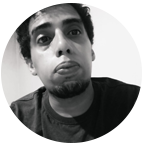
Anderson Alves dos Santos | BRAZIL |
Philosophy student and collaborator the extension project of UNILA Right to poetry.
